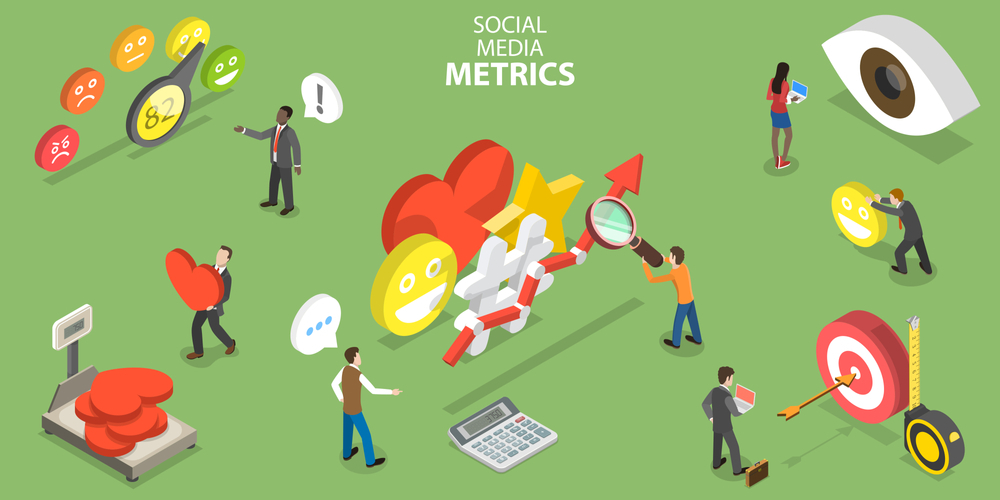Social metrics are the various measurements used to evaluate the effectiveness of a social media strategy or campaign. These metrics provide insights into the performance of a brand’s social media activity, including the reach of social media posts, engagement rates, conversions, and other important indicators of success. Without these metrics, it would be challenging to understand the impact of social media activity on a brand’s overall marketing efforts. Social metrics enable brands to track their progress, identify areas for improvement, and make data-driven decisions about future social media strategies.
By analyzing social metrics, brands can gain valuable insights into how their target audience is interacting with their content, identify the most effective channels for reaching their audience, and refine their social media tactics to better meet their marketing objectives. Additionally, social metrics can help brands understand how their social media activity impacts other areas of their business, such as customer engagement, lead generation, and overall brand reputation. In all, social metrics are a critical tool for any business looking to achieve success on social media. By regularly measuring and analyzing social metrics, you can continuously optimize your social media activity and ensure that your social media efforts are aligned with your broader marketing goals.
Reach as a metric
Reach is a common social metric used to describe the total number of unique individuals who have been exposed to a particular piece of content, such as a social media post, advertisement, or email campaign. It is often used to evaluate the effectiveness of a social media strategy or campaign, as well as to measure the potential impact of a particular message or idea.
Reach can be calculated in a variety of ways depending on the platform being used. For example, on Facebook, reach is defined as the number of people who saw your content in their News Feed, while on Twitter, reach is calculated based on the number of times your tweet appears on users’ timelines. Overall, reach is an important social metric because it provides insight into how many people are being exposed to a particular message or piece of content, which can help organizations determine the effectiveness of their social media strategies and make data-driven decisions to improve their outreach efforts.

Reach and Impression
While reach refers to the total number of unique individuals who have been exposed to a particular piece of content, such as a social media post, advertisement, or email campaign, and represents the number of people who have seen the content at least once, regardless of whether they engaged with it or not, Impressions, refer to the total number of times a piece of content has been displayed on a screen. This includes multiple views by the same user. For example, if a user scrolls past a post in their feed, that counts as one impression. If they scroll past the same post again, that counts as another impression.
The significance of reach as a metric lies in its ability to measure the potential impact of a piece of content on a wider audience. While impressions can provide a sense of how frequently a piece of content is being displayed, reach is a more accurate measure of the size of the potential audience. Reach can also help businesses evaluate the effectiveness of their social media strategy in terms of expanding their brand’s visibility and awareness among new audiences. Also, reach is often used as a starting point for calculating other social media metrics, such as engagement rates, click-through rates, and conversion rates. By understanding the reach of your content, you can better understand the engagement levels of your audience, as well as identify areas where you can improve your social media strategies to drive more conversions and revenue.
Reach Vs Other Social Metrics
Have you heard someone say, reach is a vanity metric and should not be measured? I believe that is limiting
The relationship between reach and other social media metrics is essential for businesses to understand. Reach is a foundational metric that can provide valuable insights into how other metrics, such as engagement rates and conversion rates, are performing. For example, businesses can use reach data to calculate engagement rates, which measure the percentage of people who engaged with a piece of content (such as liking, commenting, or sharing) out of the total number of people who saw the content (i.e., the reach). This calculation can help businesses understand how engaging their content is for their audience, and identify opportunities to improve their social media strategy to drive more engagement.
Similarly, reach can inform conversion rates, which measure the percentage of people who took a desired action (such as making a purchase or filling out a form) out of the total number of people who saw the content. By understanding the reach of their content, businesses can better understand the potential audience for their campaigns and identify opportunities to optimize their content to drive more conversions. Moreover, reach can inform social media strategy in a variety of ways. By analyzing reach data, businesses can gain insights into which channels and types of content are most effective for reaching their target audience. For instance, if a particular social media channel consistently drives high reach rates, you may want to focus more on that channel to maximize its potential audience. Alternatively, if certain types of content tend to have higher reach rates, you can adjust your content strategy accordingly to better resonate with your audience. By tracking reach over time, you can monitor how your social media efforts are contributing to the growth of your audience and improving brand visibility.
Measuring and Analyzing Reach
Here are some insights on the tools and methods for measuring reach, best practices for analyzing reach data, and how to use reach data to optimize social media campaigns, as well as some examples of companies using reach to drive social media success.
Tools and Methods for Measuring Reach
There are various tools and methods for measuring reach on social media platforms. Some of the most common ones include:
- Social media analytics tools: Most social media platforms offer their own analytics tools that can be used to track reach and other metrics. For example, Facebook Insights, Twitter Analytics, and Instagram Insights all provide data on reach and engagement.
- Third-party analytics tools: There are also many third-party analytics tools that businesses can use to track social media performance. Some popular examples include Hootsuite, Sprout Social, and Buffer.
- Web analytics tools: Web analytics tools like Google Analytics can be used to track website traffic from social media platforms. This data can be used to calculate the reach of social media campaigns that drive traffic to a website.

Best Practices for Analyzing Reach Data
When analyzing reach data, there are several best practices to keep in mind. These include:
- Segmenting data: To gain deeper insights into reach, businesses should segment their data by factors such as channel, content type, and audience demographics.
- Comparing data over time: Businesses should also compare reach data over time to identify trends and patterns in audience behavior.
- Combining data with other metrics: Reach should be analyzed in conjunction with other metrics like engagement rates and conversion rates to gain a more holistic understanding of social media performance.
How to Use Reach Data to Optimize Social Media Campaigns
To optimize social media campaigns using reach data, businesses can follow these steps:
- Identify areas for improvement: Analyze reach data to identify channels, types of content, and audience demographics that are underperforming.
- Test new strategies: Use insights from reach data to inform the development of new social media strategies, such as creating new types of content or targeting new audience segments.
- Track progress: Monitor the impact of changes to social media strategies by tracking reach data and other metrics over time.
Examples of Companies Using Reach to Drive Social Media Success
- Nike: Nike has a massive social media following, with over 100 million followers across various channels. The company uses reach data to identify which types of content perform best with different audience segments and uses this information to optimize its social media campaigns.
- Coca-Cola: Coca-Cola has a strong presence on social media, with over 110 million followers on Facebook alone. The company uses reach data to track the impact of its social media campaigns on brand awareness and reputation.
- Airbnb: Airbnb uses social media to promote its platform and reach new audiences. The company tracks reach data to identify which channels and types of content are most effective at driving engagement and conversions.
If someone ever said reach is dead or there is no need to measure reach, just smile. Measuring reach is a crucial part of evaluating social media performance. By using the right tools and methods, analyzing data effectively, and using insights to optimize campaigns, businesses can drive social media success and achieve their marketing goals.

